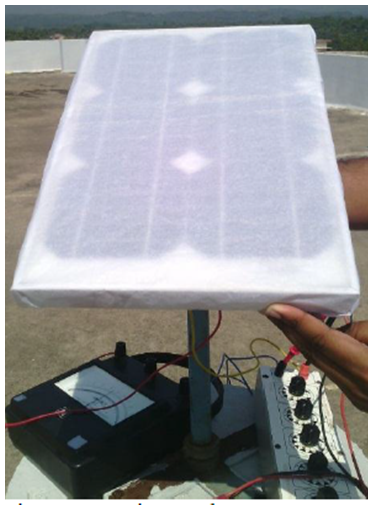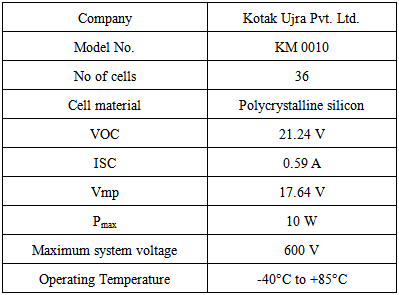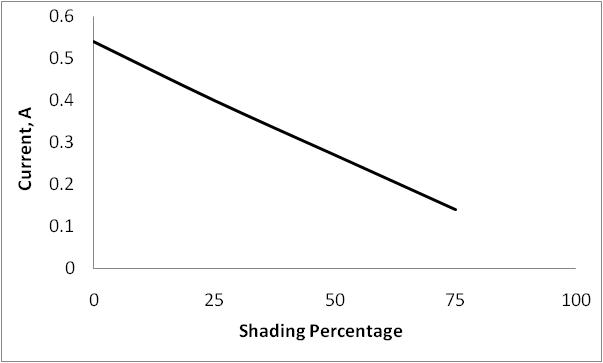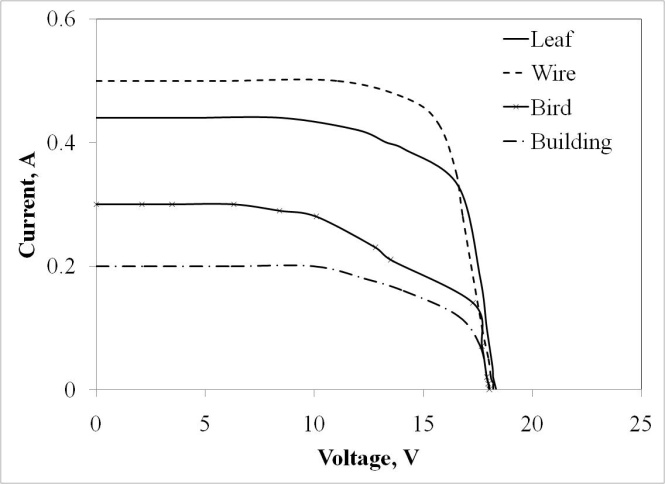Sathyanarayana P. 1, Rajkiran Ballal 2, Lakshmi Sagar P. S. 1, Girish Kumar 1
1SDM Institute of Technology, Ujire, India
2Mangalore Marine College and Technology, Kuppepadavu, India
Correspondence to: Sathyanarayana P. , SDM Institute of Technology, Ujire, India.
| Email: |  |
Copyright © 2015 Scientific & Academic Publishing. All Rights Reserved.
Abstract
Solar panels are gaining importance as a major alternate source of energy in the prevailing condition of depleting non renewable energy sources. Photovoltaic (PV) modules are being increasingly used in large as well as small scale installations. The performance of PV panels is affected by the shading effect due to trees, passing of clouds, neighboring buildings and any other means. This paper is an attempt to carry out systematic study of the effect of shading on the Power output, Fill factor and Efficiency of solar panel. A direct correlation was found between short circuit current and solar irradiation under uniform shading conditions. On the other hand, non uniform shading conditions yielded a variety of performance behavior. Such shading conditions should be avoided for better performance of solar panels.
Keywords:
PV module, Irradiation, Shading, Fill factor
Cite this paper: Sathyanarayana P. , Rajkiran Ballal , Lakshmi Sagar P. S. , Girish Kumar , Effect of Shading on the Performance of Solar PV Panel, Energy and Power, Vol. 5 No. 1A, 2015, pp. 1-4. doi: 10.5923/c.ep.201501.01.
1. Introduction
Energy demand in India as well as the globe is increasing day by day. This demand cannot be met only by the conventional sources. As a result, several alternative energy sources are being explored. Solar energy is one such promising source which has great potential to meet the growing need. Photo Voltaic (PV) technology is commonly used to generate electricity using sun’s energy [1-3].A Photo Voltaic (PV) system consists of an array of solar panels to convert solar energy to electricity. Each solar panel is an arrangement of PV cells, made up of semiconductor materials. The capacity of PV cell can be estimated by knowing cell efficiency and fill factor (FF) [4]. The efficiency of a PV cell is defined as the ratio of peak power output to input solar power and is calculated as:  where, Vmp is the voltage at peak power, Imp is the current at peak power, I is the solar intensity per square meter and A is the area on which solar radiation falls. The efficiency will become highest, if the PV cell delivers maximum power for the right combination of environmental conditions of irradiance and temperature [5].The fill factor was estimated using the relation:
where, Vmp is the voltage at peak power, Imp is the current at peak power, I is the solar intensity per square meter and A is the area on which solar radiation falls. The efficiency will become highest, if the PV cell delivers maximum power for the right combination of environmental conditions of irradiance and temperature [5].The fill factor was estimated using the relation: The fill factor of a PV panel is an important performance indicator. Although physically unrealizable, an ideal PV panel technology would produce a perfectly rectangular I-V curve in which the maximum power point coincided with (Isc, Voc). A typical solar cell produces about 0.5 V only and by connecting them together in series inside the panel, a more useful voltage can be achieved. Most solar panels are rated at 12 V, although higher voltage panels are also available [6-7]. A major challenge in using a solar PV source containing a number of cells in series is to deal with its non-linear internal resistance. The problem gets more complex when the array receives non-uniform shading. Shade is a significant design factor affecting the performance of many Photovoltaic systems. Measuring the extent of shade on a solar array can be challenging due to the fact that shadows move as the sun position moves throughout the day and year. This is further complicated by the changes in the source of shade itself. For example, a tree can sway in the wind or lose its leaves during the winter, changing the type of shade it casts on a solar array [8-9]. Shade impact depends on the severity and area of the shade. It may cause current mismatch which results in loss of power [10]. In this work, the effect of uniform and non-uniform shading on the performance of PV panel is investigated.
The fill factor of a PV panel is an important performance indicator. Although physically unrealizable, an ideal PV panel technology would produce a perfectly rectangular I-V curve in which the maximum power point coincided with (Isc, Voc). A typical solar cell produces about 0.5 V only and by connecting them together in series inside the panel, a more useful voltage can be achieved. Most solar panels are rated at 12 V, although higher voltage panels are also available [6-7]. A major challenge in using a solar PV source containing a number of cells in series is to deal with its non-linear internal resistance. The problem gets more complex when the array receives non-uniform shading. Shade is a significant design factor affecting the performance of many Photovoltaic systems. Measuring the extent of shade on a solar array can be challenging due to the fact that shadows move as the sun position moves throughout the day and year. This is further complicated by the changes in the source of shade itself. For example, a tree can sway in the wind or lose its leaves during the winter, changing the type of shade it casts on a solar array [8-9]. Shade impact depends on the severity and area of the shade. It may cause current mismatch which results in loss of power [10]. In this work, the effect of uniform and non-uniform shading on the performance of PV panel is investigated.
2. Experimental
A rectangular PV panel (450 mm x 280 mm x 30 mm) mounted on an adjustable stand was used for investigating the effect of shading. The panel was fixed at 30 inclination towards south. The angle of inclination was decided on the basis of previous investigations [9]. Two types of shading experiments, namely, uniform and non-uniform, have been conducted. For uniform shading, butter papers were used in different quantities to obtain different percentage of shading (Figure 1). For non-uniform shading, different regions were selectively shaded using physical objects, replicating the shades of leaves, cables, birds and buildings (Figure 2). I-V measurements were taken in each case using the normal practice for constant irradiance of 735 kJ/m2/day [2, 3, 7, 9]. Each experiment was repeated at least thrice to get consistent readings and average readings were reported. Power output, fill factor and conversion efficiency were also determined for each experiment. | Figure 1. Solar panel under uniform shading |
 | Figure 2. Solar panel under non uniform shading |
The specification of the panel is provided in Table 1.Table 1. Specification of PV panel
 |
| |
|
3. Results and Discussion
Uniform shading CharacteristicsFigure 3 shows the I-V characteristics of solar panel experimental set up under uniform shading condition at different levels of shading. It can be inferred that, the ISC decreases as the percentage shading is increased and a linear relationship was observed between them (Figure 5). Consequently power output also decreased with increase in shading. In the uniform shading condition, all the solar cells of the panel receive same amount of insolation for a given amount of shading. Hence, the reduction in sunlight is uniform for all the cells. As a result, short circuit current, which is directly proportional to insolation received, exhibited a direct correlation with percentage shading. However, negligible variation in fill factor and efficiency were found with increase in shading (Table 2). This is expected as the conversion efficiency of solar cell or panel is the intrinsic characteristic of the unit. Further, uniform shading of the whole panel would not have any effect on the circuitry or cell performance other than the decrease in the total power output. | Figure 3. I-V characteristics of the module under uniform shading |
 | Figure 4. P-V Characteristics of the module under uniform shading |
 | Figure 5. Effect of shading on short circuit current |
Table 2. Effect of uniform shading on the PV panel performance
 |
| |
|
Non uniform shadingThere were several interesting observations during experimentation with non-uniform shading. For example, if the shade covered one complete cell area of the panel, then the power output completely vanished. On the other hand, if the shading covered the cells partially, then the drop in the power output was proportional to area of the shade. Further, the current output was equal to the lowest among the cell individual current outputs. This can be attributed to the series connection of individual cells to make up the entire panel.Figure 6 represents I-V characteristics of PV panel subjected to a variety of non-uniform shading conditions. The approximate area of shading is indicated in the Table 3. It was observed that area of the shade had significant effect on the I-V characteristics as well as power output. The shade produced by the cable had minimum effect on the power output whereas that produced by the building model had the maximum effect.  | Figure 6. IV characteristics of the module under non-uniform shading |
 | Figure 7. P-V characteristics of the module under non-uniform shading |
Table 3. Effect of non-uniform shading on PV panel performance
 |
| |
|
Another important inference noticed during non-uniform shading experiments is the effect on fill factor and efficiency. Unlike uniform shading experiments, both efficiency and fill factor depend on the effective cell illumination obtained as a result of non-uniform shading. If shade covers a significant portion of the cell, then there is a drastic drop in efficiency as well as fill factor. For example, in the case of building model (where % shade cover is 19.82), the efficiency observed is 2.46% only. On the other hand, the leaf or cable shades have resulted in limited drop in efficiency. This could be due to the fact that shades of leaves or cables covered limited portion of the cell from sun’s exposure. In non uniform shading, all the cells in the panel will not receive same insolation. As a result, the cells that receive lower irradiance will act as loads and behave in the reverse biased condition. This leads reduction in current, power and efficiency [11]. Further, this situation may also result in the development of hotspots in the panel. Such situations must be avoided as they may not only cause drop in power output and efficiency but also damage the cells permanently.
4. Conclusions
The effect of uniform and non-uniform shading on the performance of PV panel was investigated. During uniform shading, short circuit current exhibited negative linear correlation with percentage shading. Power output also decreased linearly with shading. However, fill factor and efficiency were unaffected by shading.Non-uniform shade caused by building model affected the performance to a greatest extent whereas that by a cable affected the least. The effect was dependent on the extent of cell covered by the shade. The cells those received lower irradiance than the rest, acted as loads and caused drop in current, power and efficiency. For efficient panel performance, non-uniform shading conditions must be avoided to the maximum possible extent.
References
| [1] | J. Suryakumari and G. Sahiti, 2013, Analysis and Simulation of Modified Adaptive Perturb and Observe MPPT Technique for PV Systems. International Journal of Emerging Trends in Electrical and Electronics , 9(1), 1-7. |
| [2] | Md. Rabiul Islam, Youguang Guo, Jian Guo Zhu, M.G Rabbani, 2010, Simulation of PV Array Characteristics and Fabrication of Microcontroller Based MPPT, Proc., 6th International Conference on Electrical and Computer Engineering ICECE, Dhaka, Bangladesh, 18-20. |
| [3] | Nielsen, R. (2005) Solar Radiation, [Online]. Available: http://home. iprimus.com.au/nielsens. |
| [4] | Michael Boxwell, 2012, Solar Electricity Handbook, Greenstream Publishing, U.K. |
| [5] | Olivia Mah, 1998, Fundamentals of Photovoltaic Materials, National Solar Power Research Institute, Inc. |
| [6] | Sachin Jain, Vivek Agarwal, 2007, New current control based MPPT technique for single stage grid connected PV systems, Science Direct Energy Conversion and Management, 48 (2), 625–644. |
| [7] | R. S. Rohella, 2013, Harnessing Electrical Energy through Solar Cell Concentrators, Akshay Urja-Renewable Energy, 7(1), 29-32. |
| [8] | Solametric Application Note PVA-600-1, 2011, Guide to Interpreting I-V Curve Measurements of PV arrays. |
| [9] | Sathyanarayana P., Rajkiran Ballal I., Girish Kumar, Laksmisagar P.S., 2014, Effect of light concentration by flat mirror reflectors on the electrical power output of the photovoltaic panel Carbon – Sci. Tech. 6 (1), 342 – 348. |
| [10] | G. Shobana, P. Sornadeepika, Dr. R. Ramaprabha, 2013, Global Maximum Power Point Tracking of Photovoltaic Array under Partial Shaded Conditions International Journal of Engineering, 2(3), 219-223. |
| [11] | Chethan Singh Solanki, 2014, Solar Photovoltaics, Second Edition, Prentice-Hall of India Pvt. Limited, India. |

 where, Vmp is the voltage at peak power, Imp is the current at peak power, I is the solar intensity per square meter and A is the area on which solar radiation falls. The efficiency will become highest, if the PV cell delivers maximum power for the right combination of environmental conditions of irradiance and temperature [5].The fill factor was estimated using the relation:
where, Vmp is the voltage at peak power, Imp is the current at peak power, I is the solar intensity per square meter and A is the area on which solar radiation falls. The efficiency will become highest, if the PV cell delivers maximum power for the right combination of environmental conditions of irradiance and temperature [5].The fill factor was estimated using the relation: The fill factor of a PV panel is an important performance indicator. Although physically unrealizable, an ideal PV panel technology would produce a perfectly rectangular I-V curve in which the maximum power point coincided with (Isc, Voc). A typical solar cell produces about 0.5 V only and by connecting them together in series inside the panel, a more useful voltage can be achieved. Most solar panels are rated at 12 V, although higher voltage panels are also available [6-7]. A major challenge in using a solar PV source containing a number of cells in series is to deal with its non-linear internal resistance. The problem gets more complex when the array receives non-uniform shading. Shade is a significant design factor affecting the performance of many Photovoltaic systems. Measuring the extent of shade on a solar array can be challenging due to the fact that shadows move as the sun position moves throughout the day and year. This is further complicated by the changes in the source of shade itself. For example, a tree can sway in the wind or lose its leaves during the winter, changing the type of shade it casts on a solar array [8-9]. Shade impact depends on the severity and area of the shade. It may cause current mismatch which results in loss of power [10]. In this work, the effect of uniform and non-uniform shading on the performance of PV panel is investigated.
The fill factor of a PV panel is an important performance indicator. Although physically unrealizable, an ideal PV panel technology would produce a perfectly rectangular I-V curve in which the maximum power point coincided with (Isc, Voc). A typical solar cell produces about 0.5 V only and by connecting them together in series inside the panel, a more useful voltage can be achieved. Most solar panels are rated at 12 V, although higher voltage panels are also available [6-7]. A major challenge in using a solar PV source containing a number of cells in series is to deal with its non-linear internal resistance. The problem gets more complex when the array receives non-uniform shading. Shade is a significant design factor affecting the performance of many Photovoltaic systems. Measuring the extent of shade on a solar array can be challenging due to the fact that shadows move as the sun position moves throughout the day and year. This is further complicated by the changes in the source of shade itself. For example, a tree can sway in the wind or lose its leaves during the winter, changing the type of shade it casts on a solar array [8-9]. Shade impact depends on the severity and area of the shade. It may cause current mismatch which results in loss of power [10]. In this work, the effect of uniform and non-uniform shading on the performance of PV panel is investigated.






 Abstract
Abstract Reference
Reference Full-Text PDF
Full-Text PDF Full-text HTML
Full-text HTML

